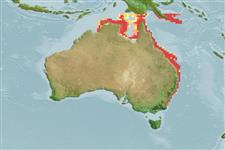Environment: milieu / climate zone / depth range / distribution range
Ecologia
marino; salmastro benthopelagico; distribuzione batimetrica 1 - 40 m (Ref. 86942). Tropical; 9°S - 37°S, 129°E - 155°E (Ref. 114953)
Western Central and Southwest Pacific: endemic to eastern and northern Australia (Ref. 114953).
Size / Peso / Age
Maturity: Lm ? range ? - ? cm
Max length : 130 cm TL maschio/sesso non determinato; (Ref. 9840); peso massimo pubblicato: 6.1 kg (Ref. 40637)
Found in mangrove swamps and estuaries (Ref. 9840). Feeds on shellfish (Ref. 6871), worms, crabs and other crustaceans (Ref. 114953). Size could possibly reach 160 cm DW (Ref. 114953). Ovoviviparous (Ref. 50449). Maturity size ca. 41 cm WD (males) and 63 cm WD (females); hatch size ca. 11 cm WD (Ref. 114953).
Life cycle and mating behavior
Maturità | Riproduzione | Deposizione | Uova | Fecundity | Larve
Exhibit ovoviparity (aplacental viviparity), with embryos feeding initially on yolk, then receiving additional nourishment from the mother by indirect absorption of uterine fluid enriched with mucus, fat or protein through specialised structures (Ref. 50449). Distinct pairing with embrace (Ref. 205).
Mould, B., 1994. A world list of rays. The scientific nomenclature and distribution of the recent Batoidea (Batoidea, Elasmobranchii, Chondrichthyes). University of Nottingham, [UK]. 82 p. (Ref. 8630)
IUCN Red List Status (Ref. 130435: Version 2024-1)
Threat to humans
Harmless
Human uses
Pesca: scarso interesse commerciale; Pesce da pesca sportiva: si
Strumenti
Special reports
Download XML
Fonti Internet
Estimates based on models
Preferred temperature (Ref.
123201): 26.9 - 29, mean 28 °C (based on 130 cells).
Phylogenetic diversity index (Ref.
82804): PD
50 = 0.5010 [Uniqueness, from 0.5 = low to 2.0 = high].
Bayesian length-weight: a=0.00468 (0.00195 - 0.01123), b=3.12 (2.92 - 3.32), in cm total length, based on LWR estimates for this (Sub)family-body shape (Ref.
93245).
Trophic level (Ref.
69278): 3.6 ±0.50 se; based on food items.
Resilienza (Ref.
120179): Basso, tempo minimo di raddoppiamento della popolazione 4.5 - 14 anni (Assuming fecundity<100).
Fishing Vulnerability (Ref.
59153): Very high vulnerability (78 of 100).
